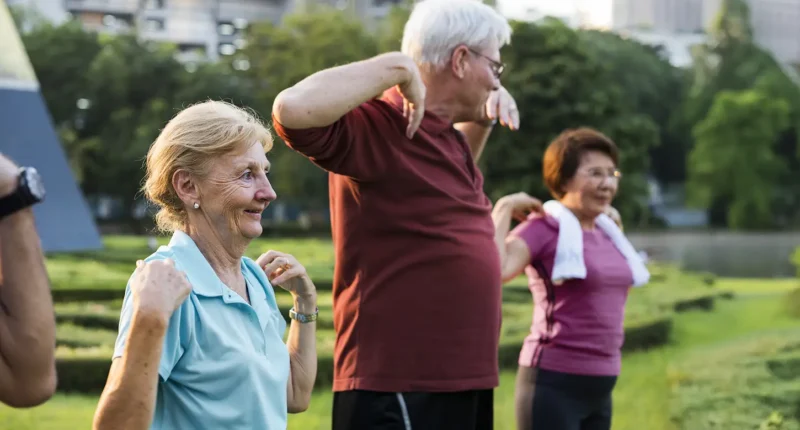Remaining active as we get older helps us add years to our life as well as life to our years. Regular exercise becomes among the most effective weapons for older persons to keep independence, avoid chronic illnesses, and raise general quality of life. This thorough handbook will assist you to develop a safe, efficient, and pleasurable exercise plan customized for your demands whether you are just beginning your fitness path or seeking to enhance your present routine.

For elderly individuals, fitness is absolutely critical. Regular physical activity can greatly lower the risk of falls, strengthen bones, boost mental health, and lessen the risk of heart disease by 35%. Exercise is a natural stress reliever that generates endorphins—those lovely feel good hormones—which is especially important for senior citizens who often suffer sleep disturbances since it also helps improve sleep quality.
Getting the Needs of Seniors
Planning exercise programs calls for particular consideration of natural changes our bodies go through with age. Knowing these changes is the first step in designing a successful fitness regimen.
Usual Health Issues
Developing an exercise regimen for older adults requires special attention to the particular physical difficulties they experience. Loss of muscle mass, reduced flexibility, and changes in balance and coordination are all results of natural aging. These changes usually start in our 30s but get more pronounced every decade following, thus it’s imperative to be proactive in solving them.

Many elderly people worry about arthritis and joint discomfort. Low-impact exercise can actually help alleviate arthritis discomfort by building the muscles surrounding joints and improving blood flow. While lowering inflammation and stiffness, the light motions help to keep the joints lubricated.
Since falls are a major cause of injury among elderly people, correcting balance problems becomes more and more important. More than 25% of those 65 or older fall every year, with more than three million treated in emergency rooms for fall-related wounds. Home hazards, medication effects, vision changes, and balance issues are among the risk factors.
As people grow older, so do problems with heart health. Moderate aerobic activity can improve cardiovascular function, reduce blood pressure, and strengthen the heart muscle, though. Preventing heart disease can be greatly aided by even mild activity such walking.
The Value of Safe, Low-Impact Exercise
For senior adults, low-impact workouts are perfect since they give all the advantages of physical activity without overburdening joints and bones. These drills let seniors stay physically active while lowering their risk of injury.
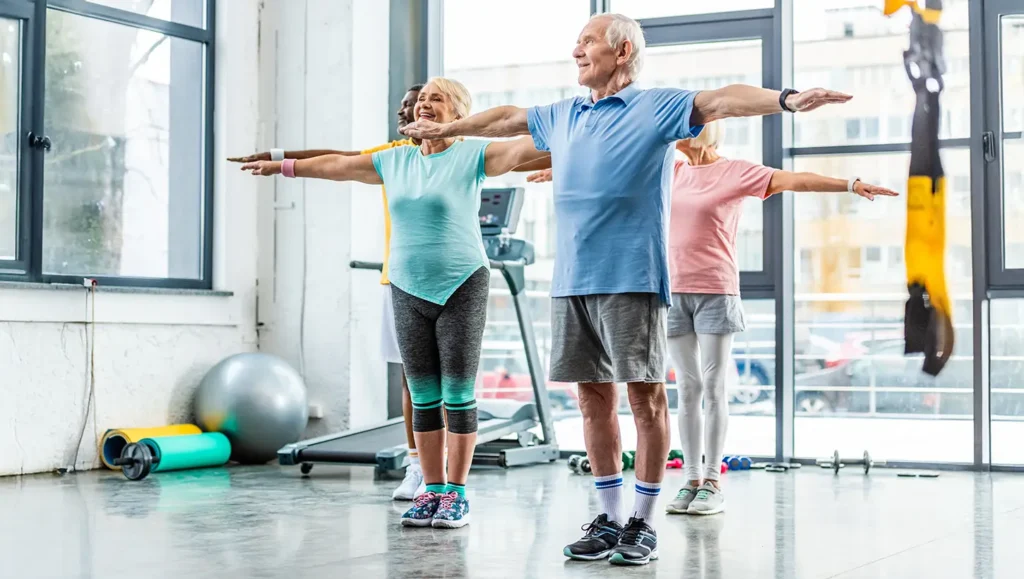
Walking, swimming, bicycling, tai chi, water aerobics, and yoga are among low-impact activities. These workouts improve cardiovascular fitness, encourage flexibility, and strengthen without the forceful movements that can be harmful on elderly joints. Especially useful are water-based exercises since the buoyancy of water aids the body while still providing resistance for muscle development.
The secret is to choose exercises that are kind on the joints yet hard enough to develop strength, balance, and endurance. Older people can progressively develop confidence with this strategy while minimizing the worry of injury that would otherwise prevent them from remaining active.
Senior Step by Step Fitness Plan
Building strength and stamina calls for a methodical strategy that gives safety top priority while developing a successful fitness regimen. A thorough step-by-step strategy created just for seniors is here.
Audible is an Audio Books Platform, where you can find any audio book of your interests including Stories, Histories and much more. Try Audible 100% Free for 30 days, Click Here to Subscribe today .

Step 1: Consult Your Doctor.
It’s imperative to speak with your doctor before beginning any fresh exercise program. This stage is especially crucial if you have a chronic health condition like heart disease, diabetes, high blood pressure, or arthritis.

Your doctor can assist you in grasping any restrictions you might have and offer advice on the kinds of exercises best suited for your particular health condition. Generally, healthy adults free of chronic health problems don’t have to get thorough medical approval before beginning a progressive workout regimen, but it is always preferable to be careful.
Among the important questions to go over with your doctor are:
- Are there any things I should not participate in?
- My medications impact my capacity to exercise?
- During exercise, what warning indicators should I keep an eye out for?
- How can I change exercises to fit my health problems?
Step 2: Establish achievable fitness objectives.
Achievable goals are essential for keeping confidence and motivation high. Begin by honestly evaluating your present degree of fitness then establishing little, specific objectives you may progressively expand on.
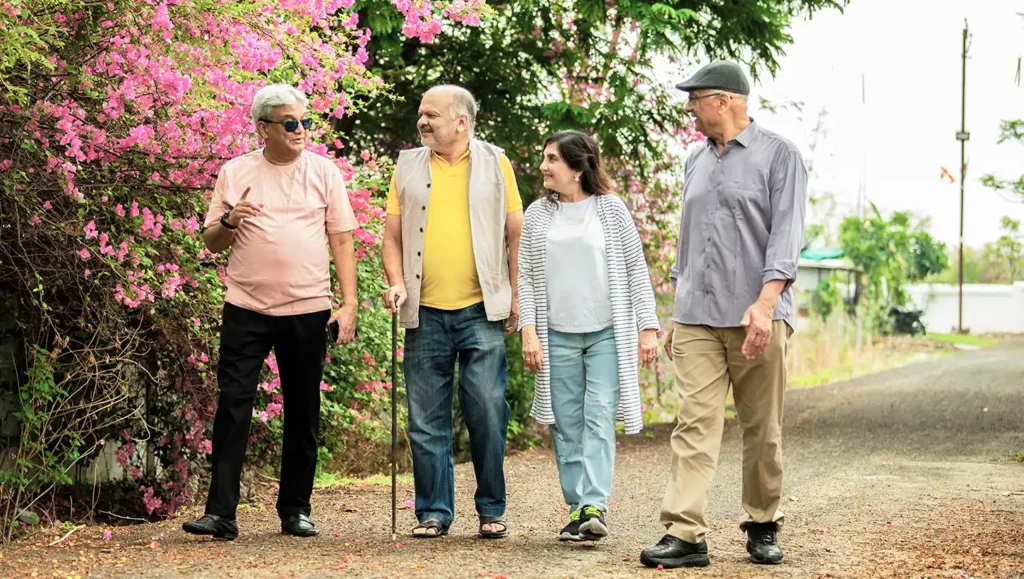
Examples of achievable starting points include:
- Walking 10 to 15 minutes daily.
- Doing 5 to 10 wall pushups
- Ten-second stand on one foot
- Doing 5 chair squats without using hands
Start gently and celebrate little victories; that is the key. As you reach these first objectives, you can slowly raise the complexity, intensity, or length of your activities. Particularly at the beginning, keep in mind that consistency takes precedence over intensity.
Step 3: Starting with stretching and Warm ups.
Every training session should start with an adequate warm-up. Good warms up helps to prepare your muscles for action, improve blood flow, and lower the risk of injury. Before progressing to more rigorous workouts, devote 5 to 10 minutes on easy movements.
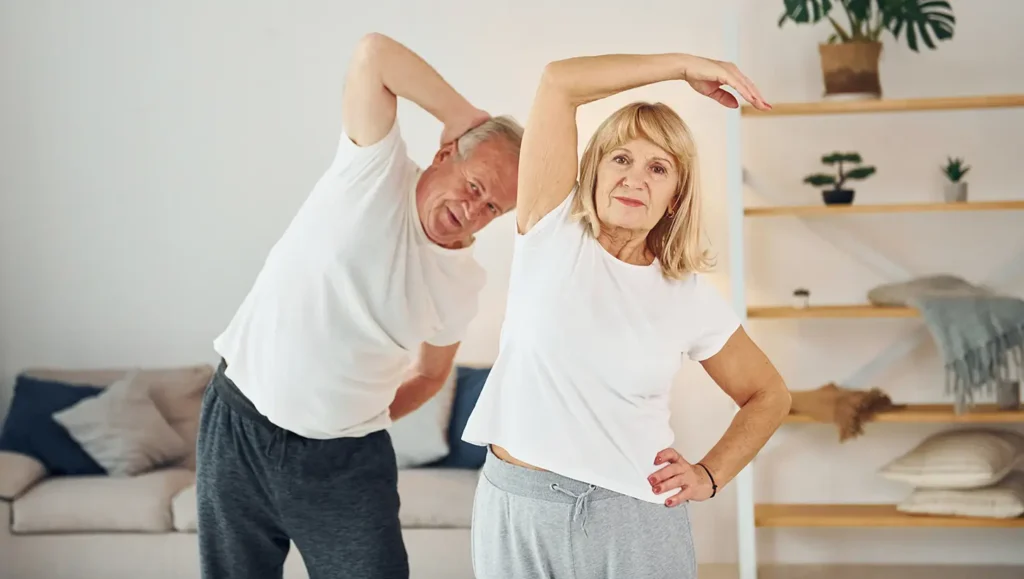
Effective warming exercises include:
- Circular arm rotations and shoulder rolls
- Gentle neck movements
- Lighting march in place
- Raises of calf and ankle circles
- Easy stretching exercises
Gradually increasing your heart rate and body temperature will help to create your warmup. Think of it as softly activating your muscles and joints so that they are ready for the task ahead. Never bypass this essential process as it lowers your risk of injury considerably.
Step 4: Low-impact cardio trials.
Heart health and general fitness depend on cardio activity. For older adults, the Centers for Disease Control and Prevention advises at least 150 minutes of moderate-intensity aerobic activity per week, which can be divided down into 30 minutes, five days a week.
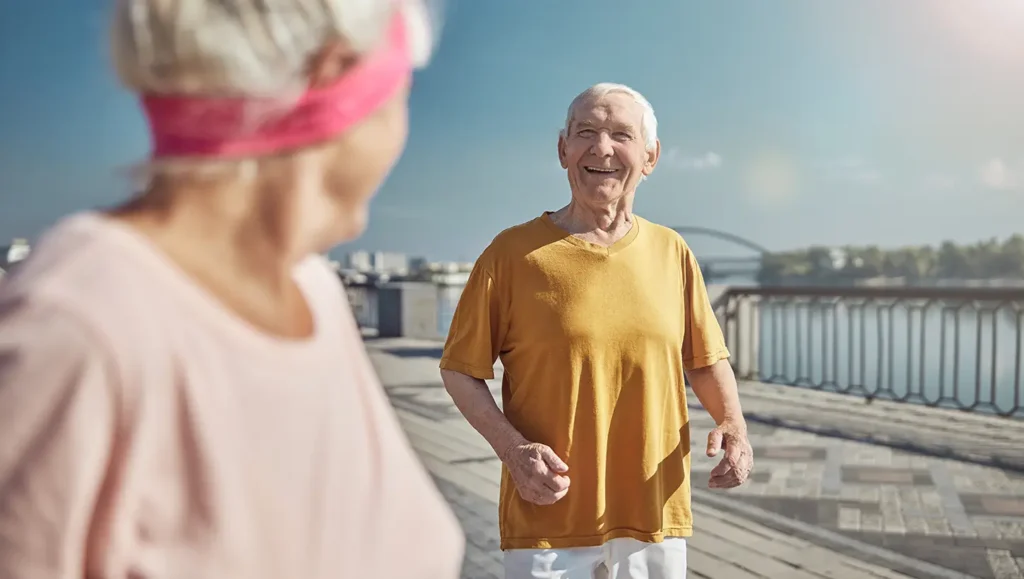
Good low-impact cardio alternatives include:
- Start with 10 to 15 minutes and then progressively raise length.
- Provides whole body workout with joint support via swimming or water aerobics.
- Riding: Either fixed or outdoor, depending on your balance and comfort level.
- Dancing: Enjoyable and sociable with great cardiovascular advantages.
Though you may speak during cardio, you should not sing. This implies you’re working at a moderate intensity suitable and successful for enhancing your cardiovascular fitness.
GROUND NEWS is a platform, where you can get latest news side by side from different news sources. Get 40% Discount Click Here
Step 5: Resistance Bands or Light Weight Stretching.
For preserving muscle mass and bone density as we get older, strength training is absolutely essential. Start with modest weights—2 to 5 pounds or resistance bands—and concentrate on good form rather than high resistance.
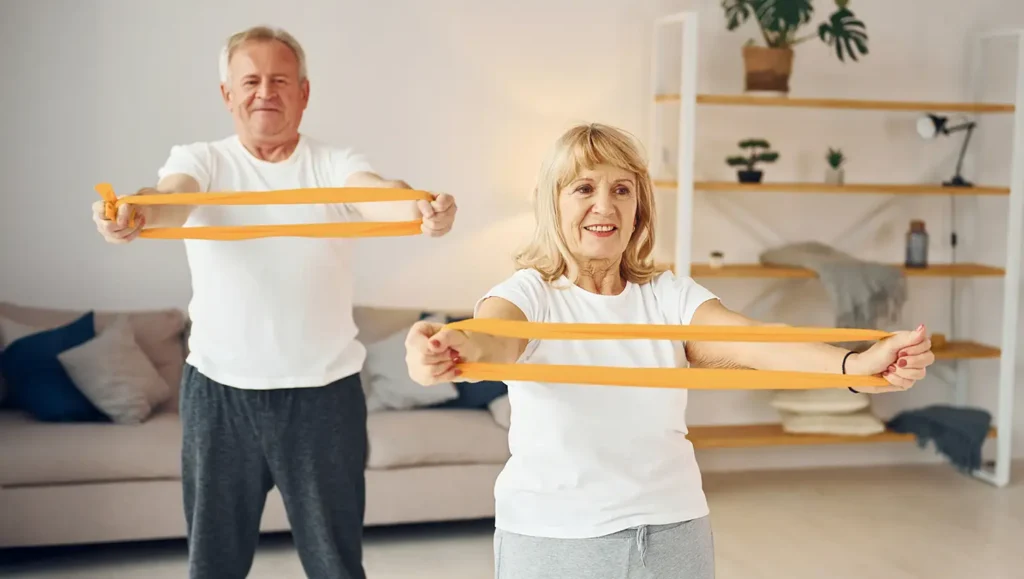
For seniors, vital strength activities comprise:
- Chair squats help you to daily activities by strengthening your leg muscles.
- Wall push-ups: Develop top body strength without risk.
- Use resistance bands or light weights for bicep curls.
- Seated leg lifts: Increase legs while seated in a chair
With two goals in mind, aiming for 2 to 3 strength training sessions per week: one to target all main muscle groups. Begin with 8 to 12 reps of every workout, doing 1 to 2 sets first and increasing to three sets as you become more strong.
Step 6: Concentrate on balance and flexibility.
Preventing falls and keeping independence depend on balance exercises. Three times per week at least, include balance training emphasizing activities that test your stability while keeping you safe.
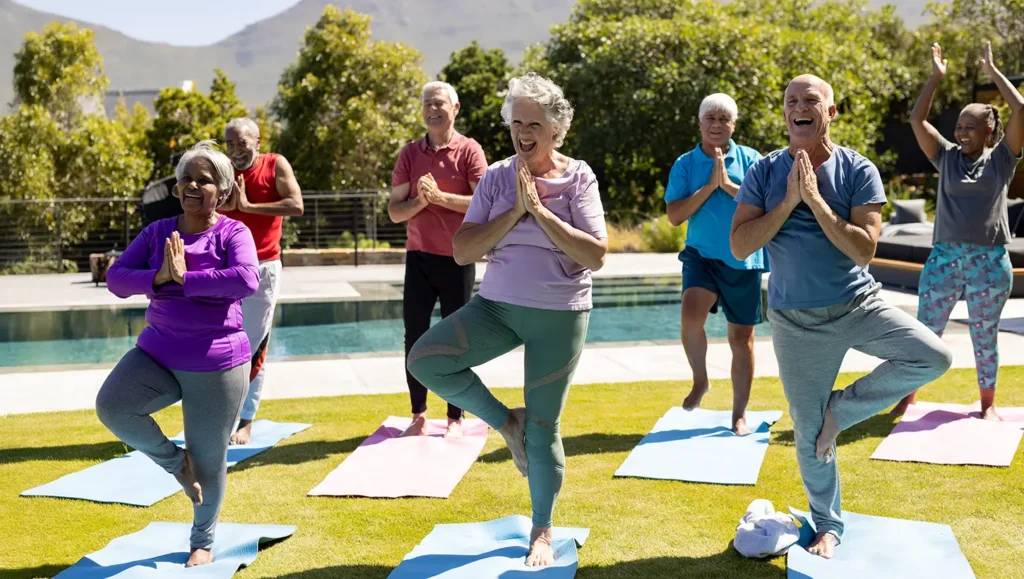
Effective balance exercises include:
- Single leg stands: Begin by supporting yourself on a chair.
- Heel-toe walking: Straight line walking exercise
- Tai chi movements: soft, fluid workouts enhancing coordination and balance
- Yoga postures: altered forms that improve stability and flexibility
Particularly helpful for seniors are yoga and tai chi. These methods provide mental health advantages via mindfulness and stress alleviation as well as balance, strength, and flexibility training.
Step 7: Cooling and Recovery.
Every workout should end with a thorough cool-down. This helps your muscle stiffness and your heart rate come back to normal slowly. Devote 5 to 10 minutes to mild stretching and relaxation.
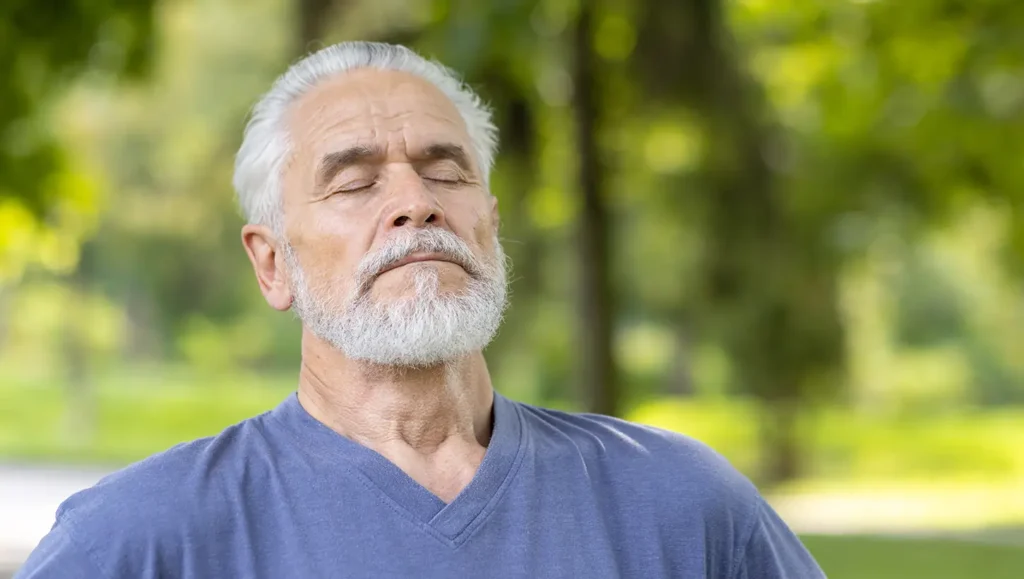
Good cooldown activities include:
- Mild marching in place or walking
- Deep breathing techniques
- Muscle group stretches
- Light stretching aimed at regions exercised during workout
The interval between workouts is as crucial as the exercise itself. Listen to your body and let enough rest between exercise days. Take an extra day to heal if you have unexpected pain or severe exhaustion.
Sample Weekly Exercise Plan
Having a regular weekly plan guarantees that you include all critical forms of activity and maintains your consistency. Below is a realistic 7-day calendar including cardio, strength training, balance exercise, and rest days.
Overview of Weekly Schedule
Monday: Walking combined with muscle training
- 20 to 30 minute fast walk
- Exercises for upper body strength include wall pushups, bicep curls, and shoulder raises.
- 5 minute stretching cooldown
Tuesday: Balance and Flexibility
- 15 to 20-minute single leg stance and heel to toe walking balancing regimen
- Soft stretching or starting yoga
- Mild domestic chores (Optional)
Wednesday: Low Impact Cardio or water workout
- 30 minutes of swimming, water aerobics, or stationary cycling
- Emphasize motions that are comfortable for your joints.
Thursday: Walking plus strength training
- Lower body strength workouts (chair squats, seated leg lifts, calf raises)
- 15 to 20 minute walk at easy tempo
- Stretching daily
Friday: Energetic recreation
- Select a hobby you like: gardening, mild tai chi, dance
- 20 to 30 minutes of motion that is not like exercise
Saturday: Lengthier Walk or Outside Activity
- 30 to 45 minutes of walking outside your house or in nature
- Light stretching
- Social activity as far as practicable, walking with friends.
Sunday: Rest Day or Gentle Movement
- Incredibly light stretching or gentle movement (Optional)
- Concentrate on rest and recuperation.
- Get ready for the week ahead.
Adjusting the Schedule
Recall that this itinerary should be adjusted to fit your interests, abilities, and needs. Start with 10 to 15 minutes and progressively raise if 30 minutes feels too long at first. More rest days or adapted activities could be required if you have persistent illnesses.
The key is constancy rather than perfection. Being motionless is worse than even 10 minutes of daily movement. You can slowly increase the duration and intensity of your exercises as you develop strength and stamina.
keeping motivated and secure
Particularly if you’re just beginning or have physical constraints, keeping enthusiasm for consistent exercise can be difficult. Still, proven techniques will assist you in keeping dedicated to your fitness objectives while giving safety first priority.
Tips to Maintain Consistency
Set realistic, reachable targets and honor little wins. Start with 10–15 minutes and then progressively increase rather than trying to work out for an hour every day. Keep your progress in a basic notebook or monitor your development over time using a fitness tracker.
Pick activities you genuinely like to make exercise pleasurable. Dancing, gardening, or grandson games can all help you if you find classic exercise dull. Variety keeps you interested and helps fight monotony. Think about rotating between several hobbies across the week.
Make a schedule and follow it. Studies reveal that older people with consistent schedules and regular routines have superior fitness results. Whatever your preference for morning or afternoon exercise, try to follow the same timetable to create a long-lasting habit.
Getting Fit Along Friend or Group
Working out with others offers motivation, social contact, and accountability. According research, seniors who workout with friends are more likely to adhere to their regimens than those who do alone.
Among the advantages of group exercise are:
- Increased accountability and motivation: It is more difficult to skip when someone is depending on you
- Social contact lowers isolation and offers emotional support.
- Having someone nearby in case of emergencies: safety
- Fun and enjoyment: Makes exercise feel less like work and more like socializing
Search in your area for senior-friendly group activities like walking groups, water aerobics classes, or SilverSneakers programs. Many Senior Centers, YMCAs, and community centers provide specialized fitness classes geared for senior citizens.
How to Prevent Hurt
Maintaining a regular exercise program depends on first valuing safety. To lower your risk of injury, adhere to these fundamental safety guidelines:
Listen to your body and honor your limitations. Though it should test you, exercise should never cause acute or intense agony. Differentiate between usual muscle exhaustion and maybe damaging pain. Stop and change the activity or take a break if anything hurts.
Begin gently and advance little by little. Rise your activity level by no more than 10% weekly. This lets your body adjust without being overburdened or damaged.
Wear the right shoes and attire. Pick shoes with strong traction and comfy clothes allowing for simple mobility. Change your workout shoes every 6 to 9 months or 250 miles of usage.
Avoid harsh temps and keep hydrated. Higher risk for dehydration among older adults exists; so, consume water before, during, and after workout. Inside exercise when the weather is too hot, chilly, or humid outside.
Employ correct form and technique. If you’re not sure how to execute an exercise correctly, think about partnering with a trained fitness expert with experience with elderly persons or enroll in a disciplined class where you might get instruction.
Making use of journals or fitness trackers
Tracking your development is really motivating and helps you remain responsible. You don’t need pricey gadgets; a basic notepad can be almost as successful as a sophisticated fitness tracker.
Benefits of fitness tracking for elderly people are:
- Greater knowledge of daily activity levels
- Through goal setting and progress monitoring, motivation
- Many trackers track heart rate, sleep, and other vital signs to better monitor health.
- Certain devices can identify falls or alert family members via safety features.
- Among basic tracking techniques include:
- Aim for modest daily step increase.
- Write what you accomplished, how long, and your feelings in exercise journals.
- Weekly activity logs: follow various forms of exercise during the week.
Many have safety features and are targeted at seniors.
Search for fitness trackers with comfortable wristbands, straightforward interfaces, and big, easy-to-read displays. Ease of use is most crucial; if it’s too complex, you won’t keep at it.
Final Thoughts
One of the greatest investments you can make in your health, independence, and quality of life is beginning and keeping up an exercise regimen as an older adult. Keep in mind that it’s never too late to start and every little action adds toward better health.
Starting slowly, listening to your body, and progressively increasing your activity level throughout time are the keys to success. If you feel progress is sluggish, don’t be disheartened; consistency is far more crucial than intensity, particularly when you start your fitness path.
Concentrate on pastimes you love since doing so makes it much more probable you will keep with your schedule over time. Find what gives you pleasure and makes you feel well, whether it be dancing to your favorite music, walking in the park, swimming at the local community center, or practicing tai chi.
Recall that exercise is about keeping your independence, lifting your mood, remaining socially connected, and continuing to enjoy all the events that define life, not only physical health. Every time you opt to move your body, you’re investing in your future self and your capacity to fully experience life.
Celebrate every accomplishment, however little. Whether you simply arrive for your workout when you weren’t in the mood, walk an additional block, or stand on one leg for a few more seconds, these victories build over time to transform your health and create long-lasting change.
Your fitness path is particular to you; therefore, be patient with yourself, remain safe, and most of all, relish the trip of getting stronger, more balanced, and more energized. You may preserve and even enhance your fitness into your golden years with constant work and the appropriate approach, guaranteeing that you have the energy and vitality to fully appreciate all the opportunities life provides.
Read Article about “Longevity: The New Luxury of 2025” Click Here
